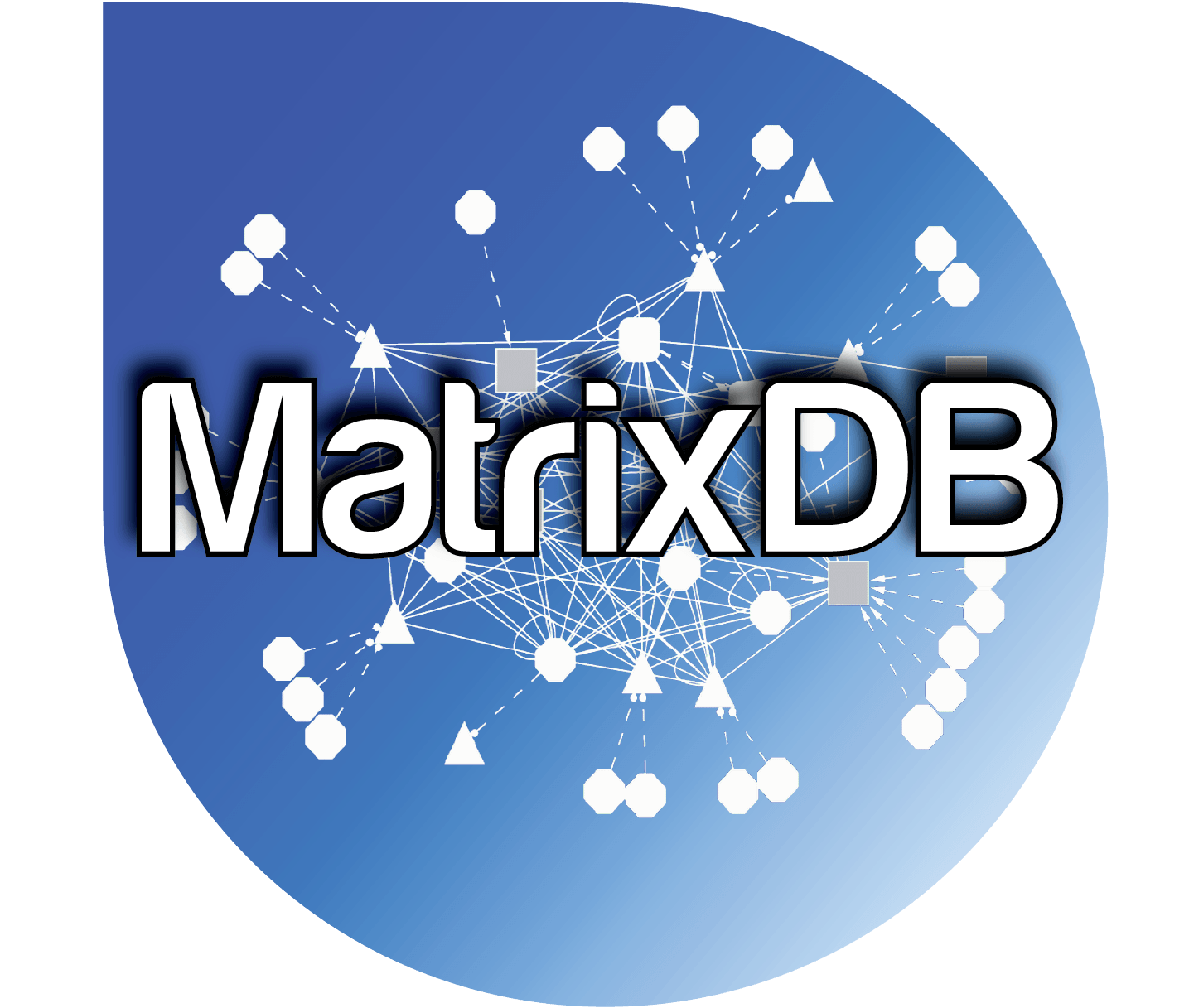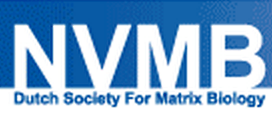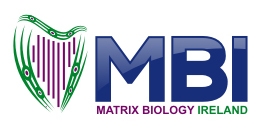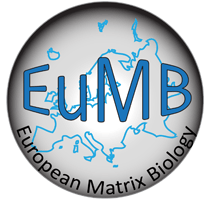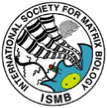A brand new version of MatrixDB is in preparation!
The database is currently undergoing substantial structural changes and, as part of this major update, more data with a focus on GAG- and proteoglycan- protein interactions, are collected and curated. The release of this new and enriched version is planned in the second half of 2023.
This work is funded by SNSF grant number: 310030_208178
MatrixDB is a freely available database focused on interactions established by extracellular matrix proteins, proteoglycans and polysaccharides
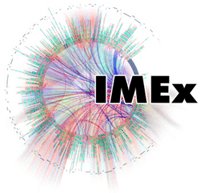

Statistics
Dynamically explore interaction networks with iNavigator.
Interaction and biomolecule data may be retrieved on the fly and incrementally added to your network.

Build biomolecule lists based on several criteria.
Getting started: play with selected interactome
- The procollagen C-proteinase enhancer-1 extracellular interaction network. Salza et al. 2014 PubMed
Beyond iNavigator
 Networks can be exported under the sif format to Cytoscape for further analysis.
Networks can be exported under the sif format to Cytoscape for further analysis.
MatrixDB data in published interaction networks
-
The interaction network of the amyloid Aβ(1-42) peptide with the ECM
The multimerization state of the amyloid-β42 peptide governs its interaction network with the extracellular matrix.
Salza R, Lethias C, Ricard-Blum S. J Alzheimers Dis. 2017 56:991-1005. PubMed -
The interaction network of collagen V
Structural in silico dissection of the collagen V interactome to identify genotype-phenotype correlations in classic Ehlers-Danlos Syndrome (EDS).
Paladin L, Tosatto SC, Minervini G. FEBS Lett. 2015 589:3871-8. PubMed -
The interaction network of Procollagen C-Proteinase Enhancer-1
Extended interaction network of procollagen C-proteinase enhancer-1 in the extracellular matrix.
Salza R, Peysselon F, Chautard E, Faye C, Moschcovich L, Weiss T, Perrin-Cocon L, Lotteau V, Kessler E, Ricard-Blum S. Biochem J. 2014 457:137-49. PubMed -
The interaction network of endostatin at the endothelial cell surface
Heparin-protein interactions: from affinity and kinetics to biological roles. Application to an interaction network regulating angiogenesis.
Peysselon F, Ricard-Blum S. Matrix Biol. 2014 35:73-81. PubMed -
The endostatin interaction network
The first draft of the endostatin interaction network.
Faye C, Chautard E, Olsen BR, Ricard-Blum S. J Biol Chem. 2009 284:22041-7. PubMed -
Heparin/Heparan sulfate interaction network
A systems biology approach for the investigation of the heparin/heparan sulfate interactome.
Ori A, Wilkinson MC, Fernig DG. J Biol Chem. 2011 286:19892-904. PubMed -
Interaction networks of basement membranes
MatrixDB: integration of new data with a focus on glycosaminoglycan interactions.
Clerc O, Deniaud M, Vallet SD, Naba A, Rivet A, Perez S, Thierry-Mieg N, Ricard-Blum S. Nucleic Acids Res. 2019 47:D376-D381. doi:10.1093/nar/gky1035. PubMed -
Interaction network of the propeptide of lysyl oxidase
Insights into the structure and dynamics of lysyl oxidase propeptide, a flexible protein with numerous partners.
Vallet SD, Miele AE, Uciechowska-Kaczmarzyk U, Liwo A, Duclos B, Samsonov SA, Ricard-Blum S. Sci Rep. 2018 8:11768. PubMed
MatrixDB interactions
Data curated in-house Core dataset enriched with interactions involving at least one "ECM" or "Secreted" biomolecule (as listed below) from IMEx partners.MatrixDB biomolecules
List of custom MatrixDB biomolecules (multimers, protein fragments, glycosaminoglycans, etc...), along with their common names and external references when available. Lists of human extracellular matrix, secreted and membrane proteins stored in MatrixDB are provided here. They are built based on the Matrisome Project as well as relevant UniProt keywords and Gene Ontology terms. Interactions involving these proteins are imported from IMEx partners using psicquic to enrich the MatrixDB core dataset.MatrixDB interaction networks
Interaction network of the propeptide of lysyl oxidase PubMed. Interaction network of the four syndecans PubMed. Interaction network of heparin/heparan sulfate PubMed.CT23D converter and GAG Builder: conversion of GAG GlycoCT codes to 3D models
This pipeline uses GAG Builder, a subset of POLYS Glycan Builder, to build 3D structure.
The models are visualized with LiteMol.
A pipeline to translate glycosaminoglycan sequences into 3D models. Application to the exploration of glycosaminoglycan conformational space. Clerc et al. 2019 Glycobiology. 29:36-44. doi: 10.1093/glycob/cwy084. PubMed
Example of GlycoCT code:
RES
1b:a-dglc-HEX-1:5
2s:amino
3b:a-lido-HEX-1:5|6:a
4s:sulfate
5s:sulfate
LIN
1:1d(2+1)2n
2:1o(4+1)3d
3:3o(2+1)4n
4:1o(6+1)5n
Biomolecules
- We use custom identifiers for all biomolecule types except proteins. An annotated list of these custom identifiers is available in the Downloads section.
The types and identifiers are as follows.
- Proteins
-
They are identified by their
UniProtKB - Swiss-Prot/TrEMBL primary Accession Number (Example: P98160). This is the most stable identifier of UniProtKB - Swiss-Prot/TrEMBL (when a protein entry is modified, the previous accession number is retained in a secondary accession number list). - Multimers
-
They are identified by a MatrixDB-specific identifier
"MULT_x_species" or"MULT_x_VARy_species" for molecular isoforms where x and y are numbers. A cross-reference to the EBI Complex Portal is provided when available. - Glycosaminoglycans
-
They are identified by a MatrixDB-specific identifier
"GAG_x" where x is a number. A cross-reference to ChEBI (Chemical Entities of Biological Interest) is provided when available. - Protein fragments
-
PFRAG in short-form, they are identified by a MatrixDB-specific identifier
"PFRAG_x_species" where x is a number. A cross-reference to the PRO feature of UniProtKB is provided when available. - Cations
-
They are identified by a MatrixDB-specific identifier
"CAT_x" where x is a number. A cross-reference to ChEBI (Chemical Entities of Biological Interest) is provided when available. - Lipidic molecules
-
Fatty-acid related biomolecules are identified by a MatrixDB-specific identifier
"LIP_x" where x is a number. A cross-reference to ChEBI (Chemical Entities of Biological Interest) is provided when available. - Synthetic peptides
-
Engineered peptides are identified by a MatrixDB-specific identifier
"SPEP_x" where x is a number. A cross-reference to ChEBI (Chemical Entities of Biological Interest) or an EBI identifier is provided when available. - Others
-
Remaining molecules are identified by a MatrixDB-specific identifier
"SMALLMOL_x" where x is a number. A cross-reference to ChEBI (Chemical Entities of Biological Interest) is provided when available.
Interactions and experiments
- MatrixDB uses the following naming convention for interactions: identifiers of the biomolecules in alphanumerical order, separated by
- Example interactions:
- CAT_1
__ P05067 - A0AVK6
__ P05067 - A4JYD4
__ A8BBG3 - Example experiments:
- CAT_1__P05067
_ 7929392_ MatrixDB_ 1 - A0AVK6__P05067
_ 21832049_ InnateDB_ 1 - A4JYD4__A8BBG3
_ 19765300_ IntAct_ 1 - A4JYD4__A8BBG3
_ 19765300_ IntAct_ 2
Tutorial
Contact
UMR 5246 CNRS - University Lyon 1 (ICBMS)
Prof. Sylvie RICARD-BLUM
University Lyon 1
43 Boulevard du 11 novembre 1918
69622 Villeurbanne cedex 07, France
Click to send an email
Citations
- MatrixDB: integration of new data with a focus on glycosaminoglycan interactions. Clerc et al. 2019 Nucleic Acids Res. 47:D376-D381. doi:10.1093/nar/gky1035. PubMed
- MatrixDB, the extracellular matrix interaction database: updated content, a new navigator and expanded functionalities. Launay et al. 2015 Nucleic Acids Res. 43(Database issue):D321-7. PubMed
- The MIntAct project--IntAct as a common curation platform for 11 molecular interaction databases. Orchard et al. 2014 Nucleic Acids Res. 42(Database issue):D358-63. PubMed
- Protein interaction data curation: the International Molecular Exchange (IMEx) consortium. Orchard et al. 2012 Nat Methods. 9:345-50. PudMed
- PSICQUIC and PSISCORE: accessing and scoring molecular interactions. Aranda et al. 2011 Nat Methods. 8:528-9. PubMed
- MatrixDB, the extracellular matrix interaction database. Chautard et al. 2011 Nucleic Acids Res. 39(Database issue):D235-40. PubMed
- MatrixDB, a database focused on extracellular protein-protein and protein-carbohydrate interactions. Chautard et al. 2009 Bioinformatics. 25:690-1. PubMed
ECM-related databases
- Laminin Database: A database of the laminins, a family of extracellular matrix proteins. Golbert et al. 2011 Nucleic Acids Res 39:D320-3. Database issue. PubMed
- Osteogenesis imperfecta & Ehlers-Danlos syndrome variant databases. Mackay et al. 1996 Clin. Genet 49:286-95. PubMed
- Alport Database: A database of all known variants in the COL4A5 gene and their clinical significance. Crockett et al. 2010 Hum. Mutat 31:E1652-7. PubMed
The matrisome
- Overview of the matrisome - an inventory of extracellular matrix constituents and functions. Hynes et al. 2012 Cold Spring Harb Perpsect Biol 4:a004903. PubMed.
- Towards definition of an ECM parts list: An advance on GO categories. Naba et al. 2012 Matrix Biology 31:371-2. PubMed.
- The matrisome: in silico definition and in vivo characterization by proteomics of normal and tumor extracellular matrices. Naba et al. 2012 Mol Cell Proteomics 11:M111.014647. PubMed
- The extracellular matrix: Tools and insights for the "omics" era. Naba et al. 2016 Matrix Biology 49:10-24. PubMed.
- Download the human and murine matrisomes from the Matrisome website
Specific extracellular interactomes
- Extended interaction network of Procollagen C-Proteinase Enhancer-1 in the extracellular matrix. Salza et al. 2014 Biochem J 457:137-49. PubMed
- Interaction networks as a tool to investigate the mechanisms of aging. Chautard et al. 2010 Biogerontology 11:463-73. PubMed
- Interaction networks: from protein functions to drug discovery, A review. Chautard et al. 2009 Pathol Biol 57:324-33. PubMed
- The first draft of the endostatin network. Faye et al. 2009 J Biol Chem 284:22041-7. PubMed
- The elastic fiber interactome. Cain et al. 2009 Mol Cell Proteomics 8:2715-32. PubMed
- A cell surface interaction network of neural leucine-rich repeat receptors. Söllner et al. 2009 Genome Biol 10:R99. PubMed
- The extracellular LRR and IgSF neuroreceptor interaction network. Bushell et al. 2008 Genome Res 18:622-30. PubMed
Interaction maps of collagens
- Molecular and structural mapping of collagen fibril interactions. Orgel et al. 2011 Connect Tissue Res 52:2-17. PubMed
- Map of the human type I collagen fibril. Sweeney et al. 2008 J Biol Chem 283:21187-97. PubMed
- Mapping the ligand-binding sites and disease-associated mutations on the most abundant protein in the human, type I collagen. Di Lullo et al. 2002 J Biol Chem 277:4223-31. PubMed
Adhesomes
- Proteomic analysis of α4 β1 integrin adhesion complexes reveals α-subunit-dependent protein recruitment. Byron et al. 2012 Proteomics 12:2107-14. PubMed
- The switchable integrin adhesome. Zaidel-Bar 2010 J Cell Sci 123:1385-8. PubMed
- Network analysis of cell adhesion: adhesomes as context-defined subnetworks. Paris et al. 2009 Commun Integr Biol 2:20-2. PubMed
- Proteomic analysis of integrin-associated complexes identifies RCC2 as a dual regulator of Rac1 and Arf6. Humphries et al. 2009 Sci Signal 2:ra51. PubMed
- Functional atlas of the integrin adhesome. Zaidel-Bar et al. 2007 Nat Cell Biol 9:858-67. PubMed
